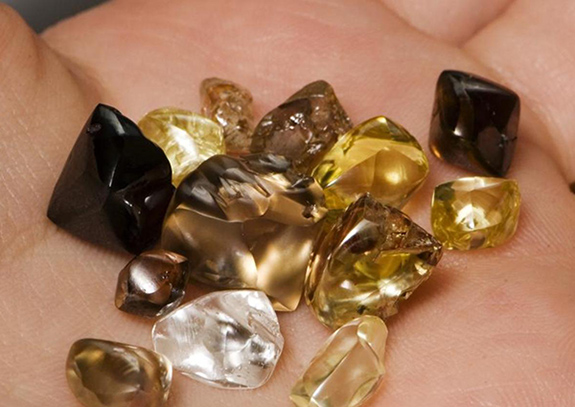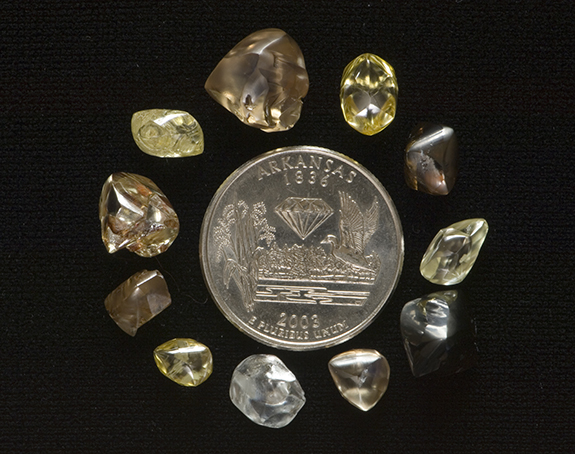May 24th, 2023
Today, we're going to share some fun stats and facts about Arkansas's Crater of Diamonds State Park, where amateur miners get to keep what they find at the only diamond site in the world that’s open to the general public.

Since it opened as a state park in 1972, Crater of Diamonds has welcomed more than 4.6 million visitors, including a record 201,000 in 2021.
Prospectors of all ages get to scour the 37½-acre search field, which is actually the exposed eroded surface of an ancient diamond-bearing kimberlite pipe. And while it may seem that the odds of finding a diamond are slim, over the 50-year history of the park, visitors have unearthed 35,250 diamonds weighing a combined 7,031 carats.
If you do the math, the probability of a park visitor actually walking away with a diamond is one in 132 — certainly better than your odds of winning the lottery or striking it rich at a casino.
Nearly 99% of the diamonds discovered at the park will fall into one of three color categories: white (clear), brown or yellow. According the Crater of Diamonds' official stats, exactly 62% of diamonds found to date were white, 20% were brown and about 17% were yellow. Slightly more than 1% were classified as "other."
Diamonds unearthed at the park average 1/5th of a carat, but about 21 per year will weigh in at 1 carat or more.

The largest diamond ever discovered in the United States was unearthed in 1924 during an early mining operation in Murfreesboro, which is now the site of Crater of Diamonds Park. Named the "Uncle Sam," the white diamond with a pink cast weighed 40.23 carats.
It was later cut into a 12.42-carat emerald shape. The Uncle Sam is now part of the Smithsonian’s mineral and gem collection and can be seen at the National Museum of Natural History in Washington, DC. A marker at the park tells the story of the Uncle Sam and points to the spot where the gem was found.
Park interpreter Tayler Markham explained in a recent article on the park's website how a diamond’s color is influenced by its journey from deep within the earth to the surface.
Markham, who has a degree in geoscience, explained that while all diamonds are made from carbon, white (or clear) diamonds are closest to a pure carbon crystal. White diamonds found at the park often exhibit a unique silvery sheen that makes them appear opalescent. This is caused by tiny inclusions that scatter the light passing through the gem.
Brown diamonds at the park owe their color to what Markham calls "plastic deformation," a structural anomaly that occurs during the diamond's formation. This event creates gaps in the crystal lattice that affect the way light is absorbed by the diamond. Brown diamonds absorb all colors except red and green wavelengths, making them appear brown.
In 2020, Arkansas native Kevin Kinard found the largest brown diamond in the park’s history, a 9.07-carat brandy brown gem he named the "Kinard Friendship Diamond."
Yellow diamonds, noted Markham, are created when nitrogen is absorbed into the diamond's crystal structure during formation. Nitrogen impurities absorb blue light and reflect yellow wavelengths, giving the diamond a yellow hue. The intensity of the color depends on the amount of nitrogen in the diamond's chemical composition.
One of the most famous yellow diamonds discovered at the park is the 4.25-carat "Kahn Canary Diamond." The gem was left uncut and placed in a ring, worn by First Lady Hillary Clinton at her husband’s Presidential Inaugural Galas in 1993 and 1997.
Tickets to the park cost $13 for adults and $6 for children 6 to 12 years old. Children younger than 6 get to enjoy the park for free.
Credit: Image courtesy of Arkansas State Parks.

Since it opened as a state park in 1972, Crater of Diamonds has welcomed more than 4.6 million visitors, including a record 201,000 in 2021.
Prospectors of all ages get to scour the 37½-acre search field, which is actually the exposed eroded surface of an ancient diamond-bearing kimberlite pipe. And while it may seem that the odds of finding a diamond are slim, over the 50-year history of the park, visitors have unearthed 35,250 diamonds weighing a combined 7,031 carats.
If you do the math, the probability of a park visitor actually walking away with a diamond is one in 132 — certainly better than your odds of winning the lottery or striking it rich at a casino.
Nearly 99% of the diamonds discovered at the park will fall into one of three color categories: white (clear), brown or yellow. According the Crater of Diamonds' official stats, exactly 62% of diamonds found to date were white, 20% were brown and about 17% were yellow. Slightly more than 1% were classified as "other."
Diamonds unearthed at the park average 1/5th of a carat, but about 21 per year will weigh in at 1 carat or more.

The largest diamond ever discovered in the United States was unearthed in 1924 during an early mining operation in Murfreesboro, which is now the site of Crater of Diamonds Park. Named the "Uncle Sam," the white diamond with a pink cast weighed 40.23 carats.
It was later cut into a 12.42-carat emerald shape. The Uncle Sam is now part of the Smithsonian’s mineral and gem collection and can be seen at the National Museum of Natural History in Washington, DC. A marker at the park tells the story of the Uncle Sam and points to the spot where the gem was found.
Park interpreter Tayler Markham explained in a recent article on the park's website how a diamond’s color is influenced by its journey from deep within the earth to the surface.
Markham, who has a degree in geoscience, explained that while all diamonds are made from carbon, white (or clear) diamonds are closest to a pure carbon crystal. White diamonds found at the park often exhibit a unique silvery sheen that makes them appear opalescent. This is caused by tiny inclusions that scatter the light passing through the gem.
Brown diamonds at the park owe their color to what Markham calls "plastic deformation," a structural anomaly that occurs during the diamond's formation. This event creates gaps in the crystal lattice that affect the way light is absorbed by the diamond. Brown diamonds absorb all colors except red and green wavelengths, making them appear brown.
In 2020, Arkansas native Kevin Kinard found the largest brown diamond in the park’s history, a 9.07-carat brandy brown gem he named the "Kinard Friendship Diamond."
Yellow diamonds, noted Markham, are created when nitrogen is absorbed into the diamond's crystal structure during formation. Nitrogen impurities absorb blue light and reflect yellow wavelengths, giving the diamond a yellow hue. The intensity of the color depends on the amount of nitrogen in the diamond's chemical composition.
One of the most famous yellow diamonds discovered at the park is the 4.25-carat "Kahn Canary Diamond." The gem was left uncut and placed in a ring, worn by First Lady Hillary Clinton at her husband’s Presidential Inaugural Galas in 1993 and 1997.
Tickets to the park cost $13 for adults and $6 for children 6 to 12 years old. Children younger than 6 get to enjoy the park for free.
Credit: Image courtesy of Arkansas State Parks.


